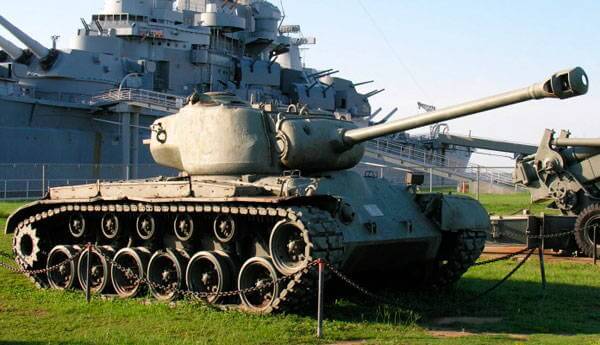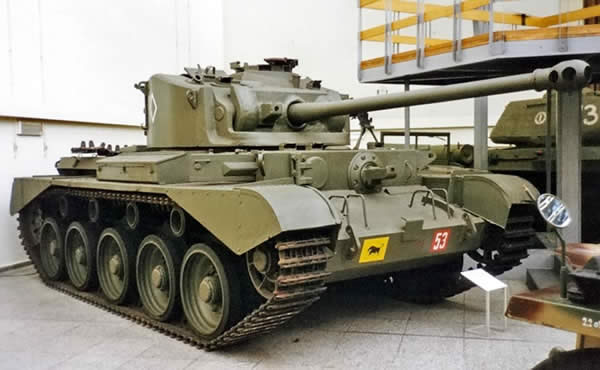Tanks have won wars in World War I and II. The history of tanks dates back to WWI when the tanks were crude to counter the problems of trench warfare. By World War II, tanks took the spotlight and became powerful. Many of the tanks during World War II were powerful, heavy and deadly. Soviets, Germans & Americans were among the countries to develop some of the most powerful tanks during World War 2. Other countries were Japan, UK, France, Italy, Czechoslovakia, and Poland were other countries in the race to develop combatant and powerful tanks. Which are the ten most powerful tanks of that era?
Check out the list of ten most powerful tanks from World War II that are dangerous, deadly and scary:
10. Comet Tank, United Kingdom
The British Comet tank was one of the most powerful cruiser tanks of WWII. It was an ambitious project to mount the incredibly powerful 17 pounder cannon on the earlier Cromwell tank. The design phase of the tank took-off in 1943 and came into service by 1944. It fought the closing battles of the Second World War. The tank’s powerful gun was enough to take out the Panther easily and Tiger at some point. The penetration power of the gun (77 mm HV) mounted on the tank was similar in power to the Panther tanks. The Comet tanks had good fighting records against other tanks. It was the most respected British tanks of WWII. It continued to serve the nation after the war until 1958.
9. KV-1, Soviet Union
The Kliment Voroshilov (KV) tanks were a series of Soviet heavy tanks. These tank series derive their name from Soviet defense commissar and politician Kliment Voroshilov. They were used by the Red Army during WWII. They were known for their heavy armor protection and were effective during the earlier phases of the German invasion of Soviet Union. A single KV-1 with some infantry support was enough to tackle large German formations during the war. Until the Germans developed a better gun to tackle the KV-1, these heavy tanks were invulnerable to any German weapons except the 8.8 cm Flak gun. These tanks were expensive than the T-34 tanks and the T-34s performed better. The production of KV-1s was stopped later in the war.
8. Panzer IV, Germany
The Panzer IV was an in-service German medium tank from WWII. Due to their continuous production and mass built, they were extensively used throughout the war by the Germans. Somewhere around 8,500 units were built. It was the only tank to remain in continuous production all through the war. Throughout the war, the design of Panzer IV upgraded extensively to become more powerful and counter new threats. It was part of the German forces in all combat theaters. Panzer IV became the most widely exported tanks of Germany. The tank was part of German corps during the Invasion of Poland on 1 September 1939. It was also active during 1941–1945 on the Eastern Front and 1944-45 on the Western Front. It is a powerful 75 mm anti-tank design is known as 7.5 cm Pak 40 L/46 led to countering Soviet T-34 and KV-1.
7. IS-2, Soviet Union
IS-2 was a Soviet heavy tank that was a successor of the KV-series of tanks. The IS-2 was put to service on April 1944 during the final stages of Battle of Berlin. It had the powerful 122 mm HE shell which was powerful enough to bring down buildings and turrets. Their explosive power was enough to blow off an enemy tank turret though it couldn’t penetrate the armor. They were good enough to destroy Panthers and Tigers which made them irreplaceable. The IS-2s were used to destroy entrenchments and bunkers with their heavy high-explosive shell. In early 1944, the IS-2 first saw action in Ukraine when it destroyed 41 Tigers and Elephants against only 8 tanks lost. While the German heavy tanks could easily knock out the IS-2 but they had no real answers to the 122mm armament which easily defeated them.
6. M26 Pershing, USA
The American M26 Pershing was a heavy/medium tank used during the final months of WWII. The tank gets its name after General of the Armies John J. Pershing, who led the American Expeditionary Force in Europe in World War I. During the Invasion of Germany, these tanks were used by the United States Army. Their ability and power were not known to the world until the Korean War began. It outmatched the T-34-85 in terms of firepower and protection during the Korean War. It was withdrawn later in 1951 from the Korean War due to hilly and muddy terrain. R. P. Hunnicutt, an American historian, and researcher of armored fighting vehicles ranks M26 Pershing ahead of Tiger I but behind the German Panther medium tank at number two spot.
5. Panther Tank, Germany
Panther Tank was a medium tank of Germany during World War II. On the Eastern and Western Fronts in Europe from mid-1943 to its end in 1945, these tanks were in use. The Panther was a replacement for Panzer III and IV to counter the Soviet T-34s. Due to its excellent firepower and protection, these tanks were considered as one of the best tanks of WWII. Though the Panther had the same engine as Tiger I, they had a better frontal hull armor, better penetrating gun and were light and fast through the terrains than the Tigers. Their only vulnerability was the weaker side armor. Similar to other German tanks, the Panther Tanks were over-engineered.
4. M4 Sherman, USA
M4 Sherman is a medium tank which is named after the American Civil War General William Tecumseh Sherman by the British. The American tank became even more powerful after modification for the United Kingdom and some Commonwealth and Allied armies. The modified version was known as Sherman Firefly or the Sherman Firefly M4A1 which is fitted with a modified turret and 17 pounder gun that could punch through a Tiger II. The M4 was the most widely used medium tank by the United States and Western Allies during the Second World War. These tanks were fast-moving because of its aircraft rotary engine. They were known for their reliability, cheap production cost and availability in great numbers. There were many variants of M4 Sherman and their power increased as the war progressed.
3. T-34-85, Soviet Union
T-34 was one of the finest tanks during World War II. In 1941, during an encounter, the German general Paul Ludwig Ewald von Kleist called it “the finest tank in the world”. The tank has been often credited as the most efficient, effective and influential tank design of the period. The Soviet medium tank had a profound and lasting effect on the field of tank design. With its incredible firepower, mobility, protection, and ruggedness, the T-34 became the most superior tanks of World War II. Later in the war, T-34’s armor and armament were surpassed, but the T-34-85 variant became the next big thing.
The improved version of T-34 proved a great deal for the Red Army. The T-34-85 had great armor and mobility. Due to its excellent armory, firepower, and accuracy, the production of these tanks crossed over 20,000. The tank was so influential that even Germany started to make an altered version of T-34 known as T-34 747(r).
2. Tiger, Germany
The power of Tiger I could be understood from an event that occurred during World War II in April 1943 when a Tiger I was captured by the Soviet. The Soviets used Tiger I to test fire with their tank – T-34. Their T-34 couldn’t penetrate the front of the heavy tank at all and the side could be penetrated only from a close range. An 85 mm anti-aircraft gun, the 52-K was able to do the job. The 52-K’s derivatives were used for the tank. Even the 52-K was able to penetrate the tank only from a distance of 600-800 meters. This distance was not enough as a Tiger could easily kill the T-34 from a distance of 1,500 to 2,000 meters.
The beast of a tank could easily take one-on-one with any tanks. The tough tank could take on other tanks with high accuracy and damage potential. It became one of the most feared tanks of WWII. There are several disadvantages of the tank such as their unreliability, difficulty to maintain and repair and construction time.
1. Tiger II, Germany
Tiger II, known as “King Tiger” among Allied troops was the most powerful tank during World War II. The powerful gun and heavy armor made the tank as a superior opponent to almost all Allied and Soviet tanks in a one-on-one confrontation. Though the tank had some disadvantages like mobility, reliability, and speed, it managed to supplement the Tiger I later in the war. The heavy tank of Germany was issued to the heavy tank battalions of the Army and the Waffen-SS. Tiger II was first deployed into combat with 503rd Heavy Panzer Battalion on 11 July 1944 during the Allied Invasion of Normandy.









